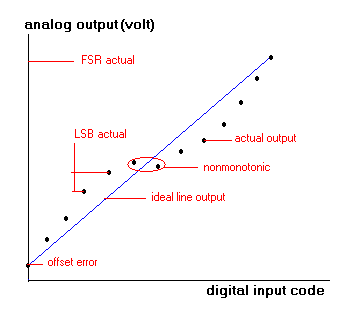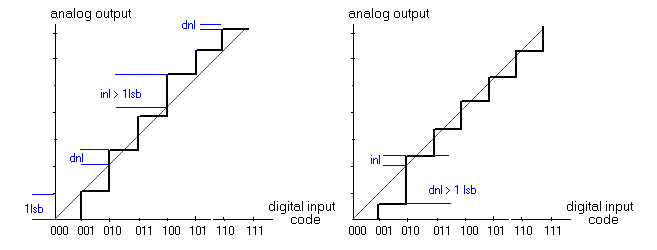This article is a brief memo about major DAC parameters.

Fig.1
Resolution - normally given in bits.
Resolution indicates the
smallest increment of its output,
corresponding to a 1 LSB input code change.
For example for 10 bit DAC, 2 power 10 = 1024 codes,
so the resolution is 1/1024
of the output range.
Full scale range (FSR) - maximum output signal for the DAC,specified
as current or voltage (ma or V).
Can be negative ,positive or both.
Offset error - difference between an ideal and actual DAC
output when zero digital code applied to the input.
Gain error - the difference between an ideal and actual output
when full scale digital code applied to the input.
Strongly depends on VREF stability.
Differential Nonlinearity - (see the drawing below) is measured
whith a ramp code applied to the input of DAC.
The step between every pair of the adjacent codes should not exceed 1 LSB.
1LSB is calculated from gain and offset measurements:
1 LSB = FSR/N-1
Differential Nonlinearity represents
the error from 1 LSB for every step,
where N=(2 power of bit number) .
Integral Nonlinearity - shows how the output differs from an ideal
line. It is also measured in LSB. Usually 1LSB is an exeptable value for nonlinearity.
Fig.2 and Fig.3 show the difference between Integral
and Differential Nonlinearity.
Offset and Gain are absolute measurements,DNL and INL
are referenced to the
zero and full scale outputs of the DAC.
SNR - signal to noise ratio. Measured with digital code representing
sine wave applied to the input. Fundamental
and harmonic components of the sine wave are filtered
out.Any remaining signal at the output of the DAC
is considered as a noise.
SNR is a ratio of the full scale sine wave output to noise
level.
Some companies specify SINAD parameter. SINAD
- is a signal to noise and
distortion ratio. It is similar to SNR, but the harmonic signal components are not removed.
Specified in dB.
THD - total harmonic distortion - measured with digital
code representing sinewave,applied to the DAC input continuously.
The output is analyzed in the frequency domain to find
harmonic components related
to the fundamental output signal.Specified in dB.
IM - intermodulation distortion - non harmonic product terms that appear
in the output signal due to nonlinearity
of the DAC. Measured with summed 2 sinusoid tone applied
to the input.
The output is tested on harmonic components,appearing
due to
modulation affect on non linear characteristics within
DAC.
The harmonic components are (F1+F2), (F1-F2) , (2F1+/-F2),
(F1+/-2F2) ...
Max conversion rate - it is actually max input signal frequency the
DAC can handle.The worst case is when
input signal changes from zero to max,and the output should
reach the max level and settle.
Settling time - the time required for the output to reach the
final value and remain within +-1 LSB
after overshoot.
PSRR - power supply rejection ratio .The output signal should
remain within limits while power supply
voltage changes from Min to Max.

Fig.2
Fig.3
Fig.2 shows the case when DNL is within limits (<1 lsb) and
INL is above 1lsb; Fig.3 - the opposite case.
If continuously increasing code from 0000 to 11111111 applied to the
DAC input,the output should represent
a rising staircase with equal steps. If staircase is smoothed, a perfectly
straight line should result.
The INL defines the overall straightness of this line, whereas the
DNL describes differences in amplitude
between adjacent steps in the staircase waveform.
Which of these two parameters is more important depends on the
application.
In the imaging application, it may be necessary to distinguish
between slightly different color densities
in adjacent areas of an image. Here DNL is more important .
But in an application in which a widely varying parameter like
speed must be continuously monitored,
INL is usually more important.
DNL must be less than 1lsb to garantee DAC's monotonic behavior (Fig.1).
A Monotonic DAC has an output that changes in the same direction
(or remains constant) for each increase
in the input code. The quality of monotonicy is important if
DAC is used in feedback loop.
When a non monotonic device is used in a feedback loop, the loop can
get stuck and DAC will toggle forever between 2 input codes.

